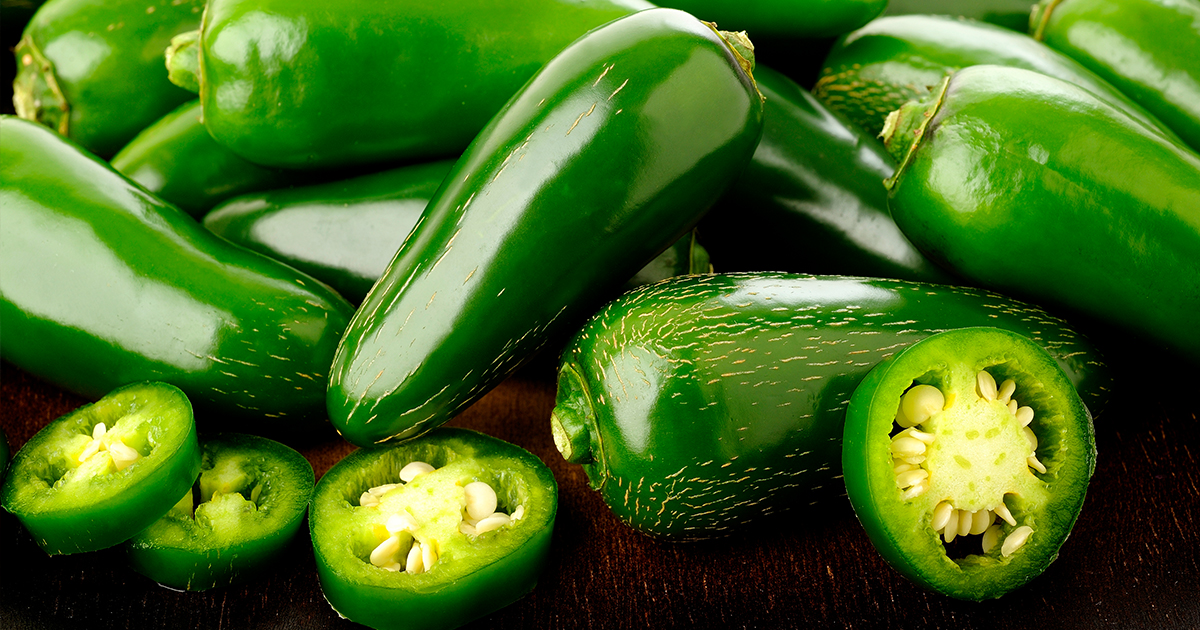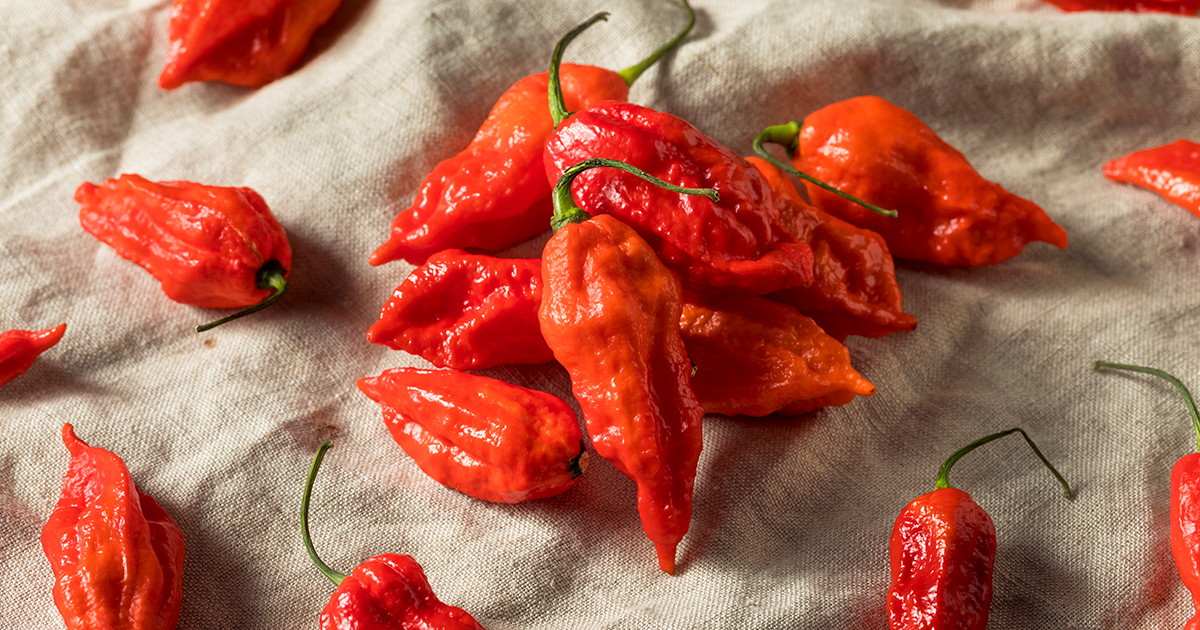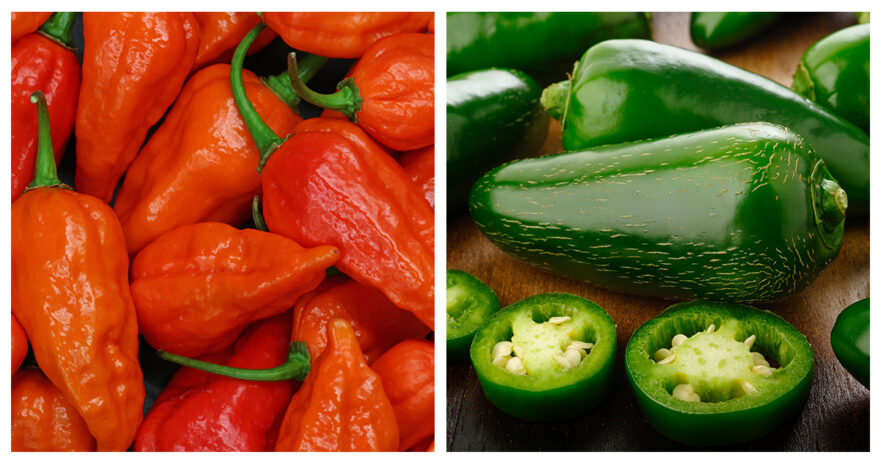Peppers are the primary ingredient of many different kinds of cuisines around the world. Each type of pepper has a unique flavor ranging from mild to hot.
Jalapeños and ghost peppers are the two most commonly used chili peppers for preparing international cuisines. However, they differ based on flavor, heat, and culinary preparation requirements. So which type of chili pepper is better for the food dish you wish to prepare?
Let’s explore the differences between jalapeños and ghost peppers to understand which is ideal for your needs.
| Jalapeño pepper | Ghost pepper | |
| SHU | 2,500 - 8,000 | 855,000 - 1,041,427 |
| Median SHU | 5,250 | 948,214 |
| Flavor | Grassy, vegetale, slightly sweet, and moderately spicy | Fruity and slightly sweet, with a very intense heat |
| Species | Capsicum annuum | Hybrid of Capsicum chinense x Capsicum frutescens |
| Origin | Mexico | Northern India |
| Uses | Salsas, guacamole, nachos, jalapeño poppers, etc. | Hot sauces, salsas, curries, pickling, etc. |
Table of contents
What are Jalapeños?

Jalapeños are popular chili peppers that add delicious flavor, heat, and spice to many renowned food dishes. If you’ve never seen a jalapeño pepper before, it is a cylindrically shaped pepper that starts with green skin and later becomes red after it fully ripens.
You don’t necessarily have to wait for the jalapeños to ripen fully before adding them to your food dishes. For instance, if you prepare food with unripened green jalapeños, they won’t taste as hot or sweet as fully ripened red jalapeños. So if you like hotter and sweeter chili peppers, wait until your jalapeños fully ripen before adding them to your food.
Don’t worry about the intensity of the heat because red jalapeños are moderately spicy at best. That is why they are used in many food dishes outside Mexico, such as in Asia and the Caribbean. In fact, you may have eaten jalapeños in the past if you’ve ever tried Thai cuisine. Many of their stir-fried dishes use red jalapeños to give them more spice and flavor.
As for Caribbean dishes, red jalapeños are used to make marinades and hot sauces. How they get cooked will determine the depth of their flavor and how well they taste with certain foods like vegetables and meats. Generally, jalapeños are smoked, roasted, or grilled before being added to a food or sauce recipe.
Experiment with the various cooking methods to learn how they affect the heat intensity of your jalapeños. In addition, take out the membranes and seeds from the jalapeños if you want a milder taste. Either that or leave them in to achieve the hottest possible results.
Remember to cook the jalapeños with care. The last thing you’ll want to do is get the pepper juices on your eyes or skin because they will severely irritate them. And if you’re planning to grow fresh jalapeños, ensure you have plenty of sunshine and space on your property. The soil should drain well too.
A mature jalapeño plant is between 2 to 3 feet tall at the end of the growing season. At this point, you can harvest the green jalapeños or leave them on the plant longer until they ripen into a red color. If grown under the proper conditions, you can see up to a dozen jalapeño peppers on one mature plant.
What are Ghost Peppers?

Ghost peppers are super-hot chili peppers. They were originally from India before they were transported and grown in different countries worldwide. The Indian name for ghost peppers is Bhut Jolokia.
It is easy to recognize mature ghost peppers because they are yellow, small, and wrinkled. Unripened ghost peppers have red or orange skin but are sometimes harvested that way. It depends on how hot you want the ghost peppers.
Yellow ghost peppers are one of the hottest chili peppers worldwide, despite their sweet and fruity flavor. Of course, you could try eating them as red or orange chili peppers, but you’ll still experience intense heat. So if you enjoy extreme spice and heat, you may be happy adding ghost peppers to your cuisine dishes.
Traditional Indian dishes often contain ghost peppers because they come from the same country. However, an increasing number of modern Mexican and Thai dishes use ghost peppers to create an intense heat sensation. But they are always added sparingly because most people cannot tolerate too many ghost peppers in one meal.
Several popular salsas, chili pastes, and hot sauces contain ghost peppers. But if you’d prefer buying ghost peppers separately, you can find them in fresh or dried powder form at most supermarkets. Home gardeners and chili pepper enthusiasts are the biggest fans of ghost pepper products because they want to add them to every meal.
Does this sound like something you would like to do? First, you need to live in a warm and humid environment, such as the ones found in subtropical and tropical areas of the world. And, of course, you need to water your plants regularly and grow them in soil with excellent drainage capabilities.
What are the similarities between Jalapeños and Ghost Peppers?
Ghost peppers and jalapeños may have different heat intensity levels and flavors, but they both come from the Capsicum plant family. You can add either one to various food dishes to achieve the most desirable hot flavor. Ghost peppers are floral and fruity, while jalapeños are tangy and sweet.
Mexican and Tex-Mex food dishes often have jalapeños, whereas ghost peppers are more common in Mexican, Indian, and Thai food dishes. If you want to add them to your food dishes, you can find them in fresh or dried powder form. The best choice depends on the meal, sauce, or soup you wish to prepare.
Ghost peppers and jalapeños are prime ingredients for salsas and hot sauces. But the ones with ghost peppers will give you more spice and heat intensity.
What are the differences between Jalapeños and Ghost Peppers?
The heat level is the primary difference between jalapeños and ghost peppers. Let’s look at some technical details to understand this better.
The Scoville rating of ghost peppers is 855,000 to 1,041,427.
The Scoville rating of jalapeños is 2,500 to 8,000.
You may be wondering, what is a Scoville rating? The Scoville rating is a way to measure the heat or spiciness of hot foods like chili peppers. If the rating is between 100 and 2,500, it is considered mild. Neither the ghost peppers nor jalapeños are mild.
Medium is between 2,500 and 30,000, meaning jalapeños have medium-high heat intensity. However, ghost peppers have a much higher rating on the Scoville scale. As a result, ghost peppers are drastically hotter and spicier than jalapeños.
It’s worth noting the difference in their appearance too. Ghost peppers are small with yellow and wrinkled skin. The standard dimensions of one ghost pepper are 2 to 3 inches long and 1 to 2 inches wide. Jalapeños are also small but with dark green and smooth skin. Each one is between 2 to 4 inches long and 1 inch wide.
Jalapeños taste a little bit tangy, sweet, and grassy. Their heat intensity is moderate at best. Ghost peppers are sweeter, fruitier, and much hotter than jalapeños. But consuming too many ghost peppers at once will cause severe discomfort, so please consume them responsibly.
If you like mild to moderate spice, then jalapeños are the best choice for an ingredient. They are popular in Mexican dishes like tacos and sauces like salsas and guacamole.
On the other hand, if you want the hottest chili peppers imaginable, try ghost peppers. Plenty of fiery hot marinades, sauces, and spice blends have ghost peppers because of the extremely hot oils and fibers.
FAQ about Jalapeño and Ghost Pepper
What is the hottest chili pepper: a jalapeño or ghost pepper?
Ghost peppers are far spicier and hotter than jalapeños. The Scoville scale indicates that ghost peppers have a rating of up to one million. Meanwhile, jalapeños only have a Scoville rating of up to 8,000. Therefore, it is clear that ghost peppers are hotter.
What kinds of cuisines use jalapeños and ghost peppers as ingredients?
Many Asian, Caribbean, Mexican, and Tex-Mex dishes have jalapeños for their mild spice and heat intensity. The jalapeños taste the best when grilled and roasted with vegetables and seafood.
As for ghost peppers, they are commonly used in Mexican, Indian, and Thai food dishes. They taste the best when added dry or fresh to your food dishes, hot sauces, or chili pastes. The hottest foods imaginable use ghost peppers to create a unique fiery flavor in your mouth.
How do you alter the heat intensity of ghost peppers and jalapeños?
To reduce the heat intensity, remove the membranes and seeds from the chili peppers before preparing them for consumption. But if you want to keep the heat intensity, leave the membranes and seeds in the chili peppers before preparing them.
How easy is it to grow jalapeños and ghost peppers?
Most home gardeners find it much easier to grow jalapeños than ghost peppers. If you have a sunny environment and well-prepared soil, you can grow them in beds or pots.
Ghost peppers are more challenging to grow because they require warm temperatures, regular humidity, frequent watering, sunshine, and excellent soil drainage. The best environments for growing ghost peppers are subtropical or tropical climates. It also takes longer to prepare ghost peppers too.
How are jalapeños and ghost peppers the same?
Jalapeños and ghost peppers are both members of the Capsicum family. You can buy them in fresh or dried powder form to add to your favorite cuisines. The choice between ghost peppers and jalapeños depends on your heat intensity preference and the recipe you are preparing. Remember, the ghost peppers are a lot hotter than jalapeños.
Can I use ghost peppers in a recipe requiring jalapeños and vice versa?
No, it is not advisable to substitute one for the other in a recipe. Even though jalapeños and ghost peppers come from the same flowering family, the ghost peppers are way hotter and spicier. You should only use ghost peppers if the person eating the food likes super-hot and spicy. Otherwise, use the jalapeños to add a mild intensity heat and spice flavor to your cuisines.

